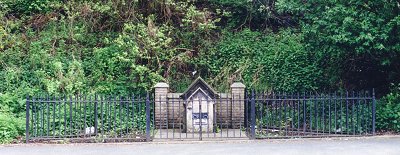|

Listing: Memorial. Dated 1901.
Commemorates the site of Wulfruna's well. The Lady Wulfrun(a)
is noted as having endowed the Collegiate church of Wolverhampton
with a Dean and Prebendaries, AD994, giving her name to the town:
Wulfrun's Heanton (High Town).
Literature: H. Thorold, Shell County Guides:
Staffordshire, 1978, p.186
Comment: Often known as "Wulfruna's Well", it started life
as a drinking fountain. The inscription on it says that it is "In
remembrance of the Lady Wulfruna A.D. 994". It also records that it
was given by Stavely Hill in 1891. The tap and drinking cup are long
gone. The wall behind and the railing around are new additons, from
the recent restoration. The bank behind was constructed for the old
Oxley sidings, which used to be on the top and which is now occupied
by an industrial estate.
Some ten years ago the memorial was dug out of the undergrowth by the
Wolverhampton Civic Society, an action which probably saved it from total
loss. More recently the City Council have had a go at it.
There is often said to have been a spring here, which is not unlikely,
but there is no sign of it now.
George T, Lawley, History of Bilston, 1893, at pp. 174 and 175, says:
Another famous local well is that once situate at Spring Vale, near Bilston,
known at one time far and wide, as Lady Wulfruna's well. In an old document
belonging to Bilston I find the following reference to it :-" To the South
of Wolferhamtune is a famous springe called Ladie Wulfrune's Sprynge, where
shee usyd to come and washe. The legende tells us that the ladie Wulfrune
prayede for that God woude endue the well wyth powers of noe ordinarie
vyrtue, inasmoche as that it hath curyd manie, as it wer myraculouslie
healynge the lame, the weake and impotent, and dyvers sufferyng fro mortall
diseases, as manie there bee thatt cann testifie."
Lawley says that the site of the well is lost but is remembered in the
name of the Springvale district. Of course there is also the Springfield
district of Wolverhampton, which is near the site of Staveley Hill's
fountain. There might have been two such wells or the document Lawley refers
to might have been referring to a well on this site.
(In the original Lawley prints a "y" to represent the letter thorn. For
ease of reading, and in the interests of correctness and pedantry, we have
given it as "th").
For further information about the Staveley Hills, click here.

|